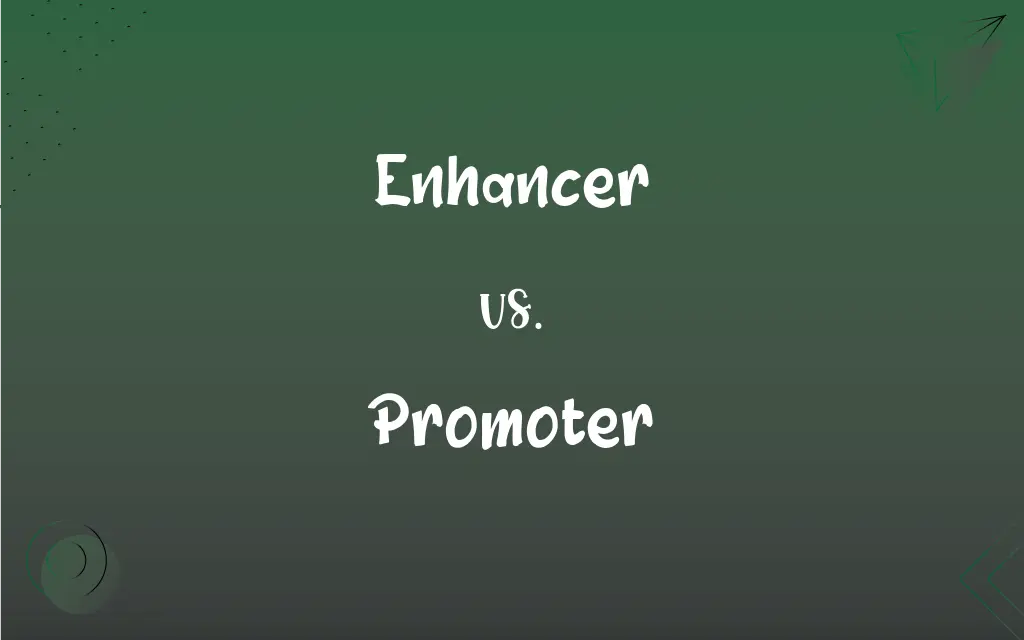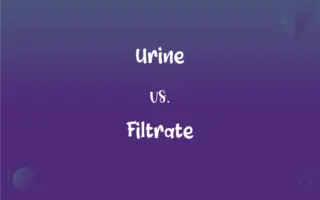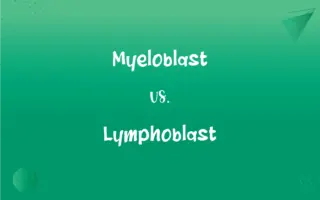Enhancer vs. Promoter: What's the Difference?
Edited by Janet White || By Harlon Moss || Updated on October 27, 2023
Enhancer boosts the transcription of a gene, while a promoter initiates it.

Key Differences
Enhancers and promoters are both critical DNA sequences responsible for the regulation of gene expression. Enhancers can be located far away from the gene they regulate, sometimes even thousands of base pairs away. In contrast, promoters are typically located close to the gene they regulate, serving as the site where transcription begins.
Enhancers function to increase the rate of transcription of a gene. They do this by binding specific proteins called transcription factors. These factors help bridge the distance between the enhancer and the promoter, forming a loop in the DNA. Promoters, on the other hand, directly interact with the machinery responsible for transcription, such as RNA polymerase.
Enhancers can be active under specific conditions or in particular cell types, thus allowing differential gene expression. The presence or absence of certain transcription factors can activate or inhibit the enhancer's function. Promoters, however, provide a more consistent control point, dictating where and when transcription should begin.
Enhancers and promoters, although having distinct roles, work in tandem to ensure that genes are expressed at the right time and in the right cells. Together, they enable the intricate regulation of genes, ensuring that cells can adapt and respond to various internal and external cues.
Comparison Chart
Location
Can be far from the gene they regulate.
Close to the start of the gene.
ADVERTISEMENT
Function
Boosts the rate of transcription.
Initiates transcription.
Interaction
Binds transcription factors.
Binds RNA polymerase and transcription factors.
Specificity
Active under certain conditions or cells.
Generally consistent control point.
Structural Formation
Forms a loop with the promoter.
Serves as the starting site.
Enhancer and Promoter Definitions
Enhancer
A DNA element that binds transcription factors to upregulate transcription.
The enhancer's effectiveness is due to its ability to attract the right transcription factors.
ADVERTISEMENT
Promoter
A DNA sequence that initiates the transcription of a gene.
The promoter serves as the starting point for RNA polymerase.
Enhancer
A region of DNA that can be located far from the gene it regulates.
Despite being thousands of base pairs away, the enhancer still influences gene transcription.
Promoter
Typically located immediately upstream of a gene.
The promoter's proximity to the gene ensures transcription begins at the correct location.
Enhancer
Can be upstream or downstream of the gene.
The enhancer's position can vary, but its influence on transcription remains critical.
Promoter
Provides a consistent control point for transcription.
The promoter dictates when and where a gene's transcription begins.
Enhancer
A DNA sequence that boosts the transcription of a gene.
The enhancer helps to increase the gene's expression under specific conditions.
Promoter
Contains specific DNA motifs recognized by transcription factors.
Transcription factors bind to the promoter's specific motifs to regulate gene expression.
Enhancer
Often tissue-specific, allowing for differential gene expression.
The enhancer active in liver cells might be dormant in heart cells.
Promoter
Directly interacts with transcription machinery.
RNA polymerase binds to the promoter to kickstart transcription.
Enhancer
To improve or augment, especially in effectiveness, value, or attractiveness
Exercises that enhance cardiovascular health.
Spices that enhance the flavor of a sauce.
Renovations that enhance the neighborhood.
Promoter
One that promotes, especially an active supporter or advocate.
FAQs
Is the promoter always close to the gene?
Yes, promoters are typically located immediately upstream of a gene.
Can enhancers be located far from genes?
Yes, enhancers can be thousands of base pairs away from the gene they regulate.
Do enhancers directly initiate transcription?
No, enhancers boost transcription rates but do not initiate it.
What is an enhancer in genetics?
A DNA sequence that boosts the transcription of a gene.
Are enhancers always active?
No, they can be active under specific conditions or in specific cell types.
Can multiple enhancers influence a single gene?
Yes, a gene can have multiple enhancers affecting its transcription.
How are enhancers identified in the genome?
Through techniques like DNAse hypersensitivity or chromatin immunoprecipitation.
Do enhancers and promoters have specific sequences?
Yes, both have specific motifs but the sequences can vary between genes.
How do enhancers and promoters interact?
Enhancers bind transcription factors which help form a DNA loop to interact with promoters.
Can enhancers be downstream of a gene?
Yes, enhancers can be both upstream and downstream of the gene they regulate.
Do all genes have associated promoters?
Yes, each gene has an associated promoter to initiate its transcription.
How does a promoter function?
It serves as the initiation site for the transcription of a gene.
Which DNA sequence binds RNA polymerase?
The promoter binds RNA polymerase to start transcription.
Are enhancers found in all organisms?
While enhancers are common in eukaryotes, not all organisms have them.
Can a mutation in the promoter affect gene expression?
Yes, promoter mutations can alter transcription initiation.
What's a core promoter?
The minimal portion of the promoter required to initiate transcription.
Do enhancers affect nearby genes only?
No, they can influence genes located far away.
How do promoters ensure accurate transcription start?
They contain specific motifs recognized by transcription machinery.
What happens if a promoter is damaged or mutated?
It can lead to reduced or altered transcription of the associated gene.
Can external factors influence enhancer and promoter activity?
Yes, environmental cues or cellular signals can influence their activity.
About Author
Written by
Harlon MossHarlon is a seasoned quality moderator and accomplished content writer for Difference Wiki. An alumnus of the prestigious University of California, he earned his degree in Computer Science. Leveraging his academic background, Harlon brings a meticulous and informed perspective to his work, ensuring content accuracy and excellence.
Edited by
Janet WhiteJanet White has been an esteemed writer and blogger for Difference Wiki. Holding a Master's degree in Science and Medical Journalism from the prestigious Boston University, she has consistently demonstrated her expertise and passion for her field. When she's not immersed in her work, Janet relishes her time exercising, delving into a good book, and cherishing moments with friends and family.































































